Yellow T-Maze Results
on Friday, November 14th, 2025 3:35 | by Daniel Döringer
I performed the first set of T-Maze experiments, which included 3IY treated flies, with red light. In this experiment I could nicely reproduce earlier results in PPM2 flies only treated with ATR. Flies initially showed weak avoidance of optogenetic stimulation, and developed a weak approach-behavior over the time course of ten minutes. In the 3IY treated flies I found similar avoidance after 1 minute of testing but, interestingly, flies kept the same level of avoidance also for a choice time of 10 minutes. This indicates that initial avoidance might be independent of dopamine, but prolonged or repeated release of the neurotransmitter from PPM2 neurons might lead to circuit changes, weakening avoidance behavior, potentially even changing it to approach.
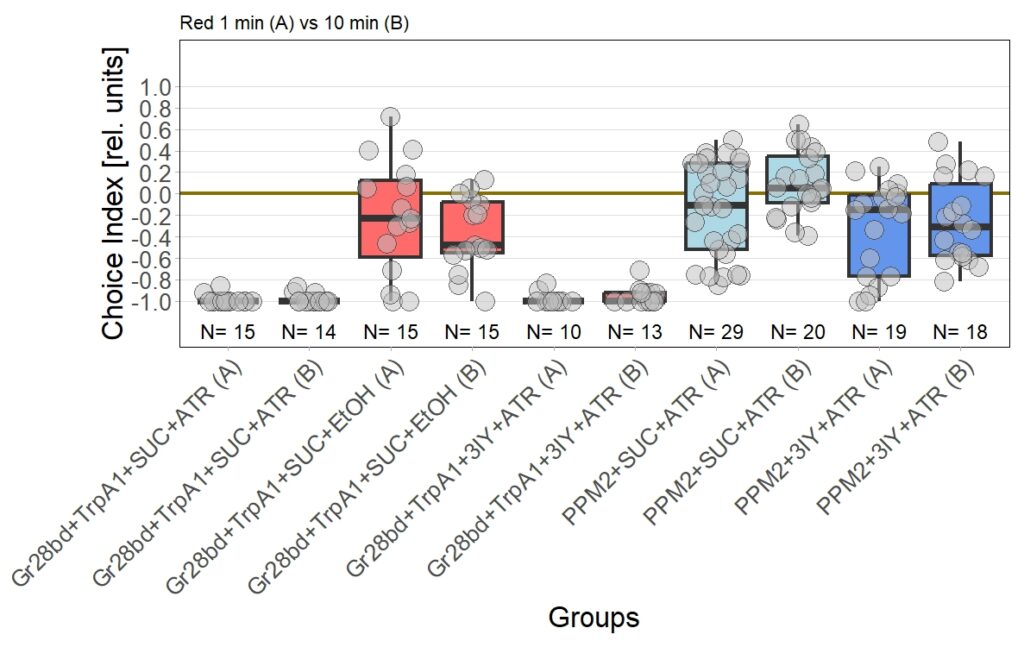
The new set of experiments uses yellow light instead of red light. This experiments are especially interesting, as I observed stronger effects for the experimental group for yellow light.
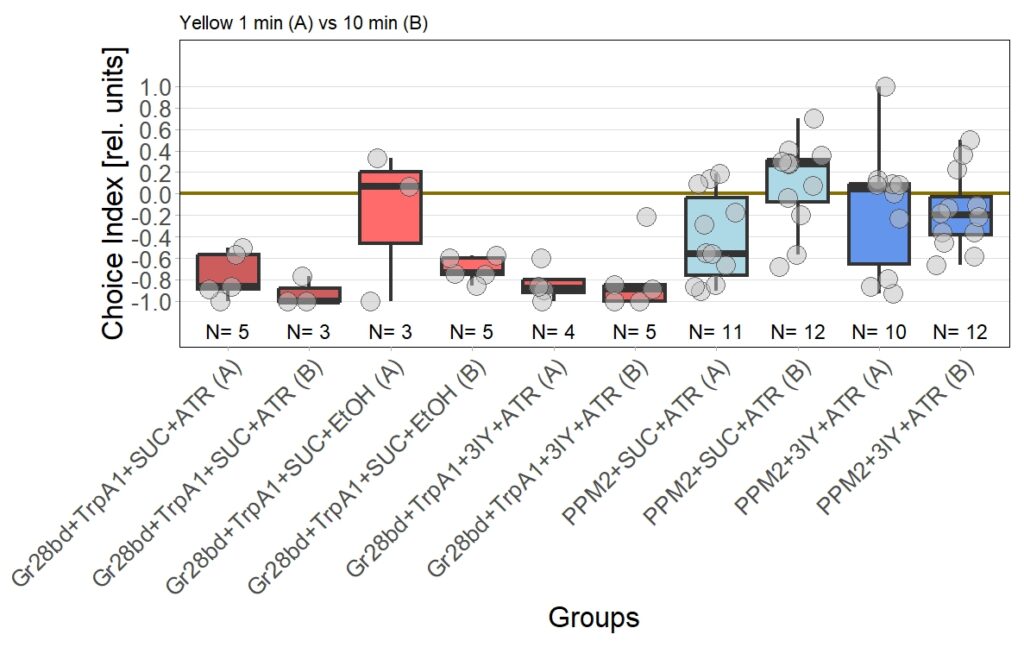
There are two main points to discuss about the data.
First, the negative control (Gr28bd+SUC+EtOH) … I was hoping that I solved the problem with the avoidance in flies that were not treated with ATR. These flies should not avoid optogenetic stimulation since without the chromophore, there should be no, or at least very weak, activation of the CsChrimson channel. Even if the sample size of 5 is rather low, it is a bit worrying that when these flies were tested for 10 minutes ((Gr28bd+SUC+EtOH (B)), they show avoidance comparable to control flies that were treated with ATR and tested for 1 minute ((Gr28bd+SUC/3IY+ATR (A)).
On the other hand, the experimental groups look pretty good. For now, I was not only able to reproduce results from the first 1 vs. 10 minute T-Maze testing with yellow light, it also seems that 3IY-treated PPM2 flies show the same phenotype as when tested in red light.
For the next few weeks I will have to increase sample sizes, aiming for 30 for each of the experimental groups. I will only include a few control groups treated with ATR, as the effect size here seems to allow for a lower N. Presumably, I will include more untreated control flies, to see whether the avoidance will persist or if the current results simply arise from the low sample size.
Update 21/11/25

Category: Biogenic Amines, Optogenetics | No Comments
Proceeding with T-Maze experiments
on Friday, October 31st, 2025 1:38 | by Daniel Döringer
After pausing T-Maze experiments because of the issues with my negative control, I should now be abled to proceed.
Since it’s been a bit more than 2 months since the last results, this was the state of the experiments back then:
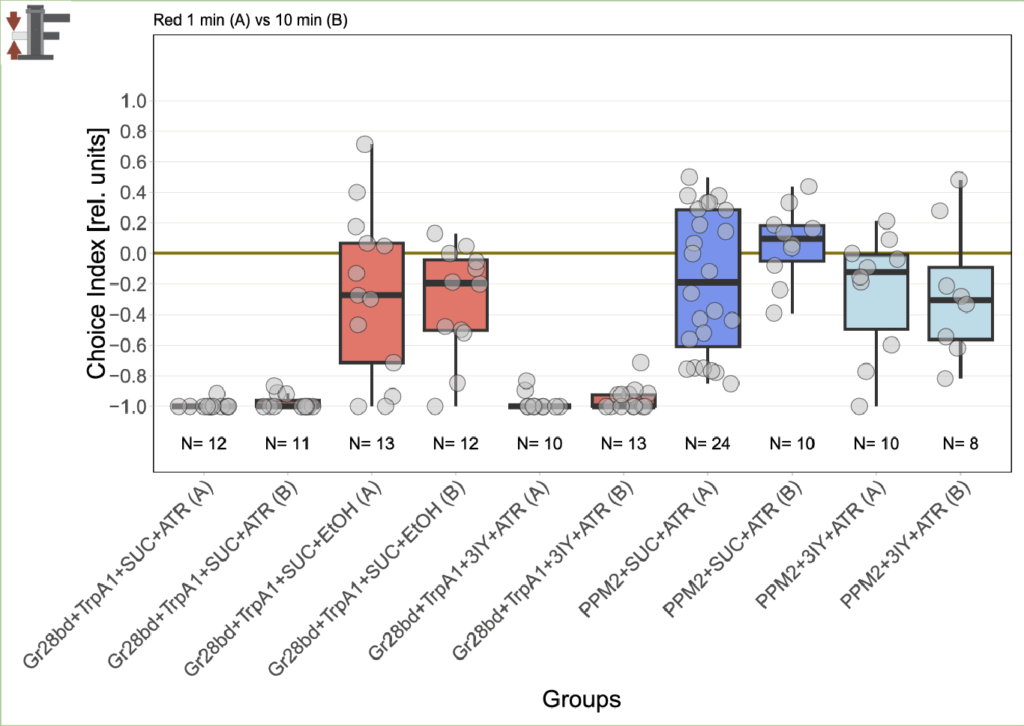
Now I added the following results:
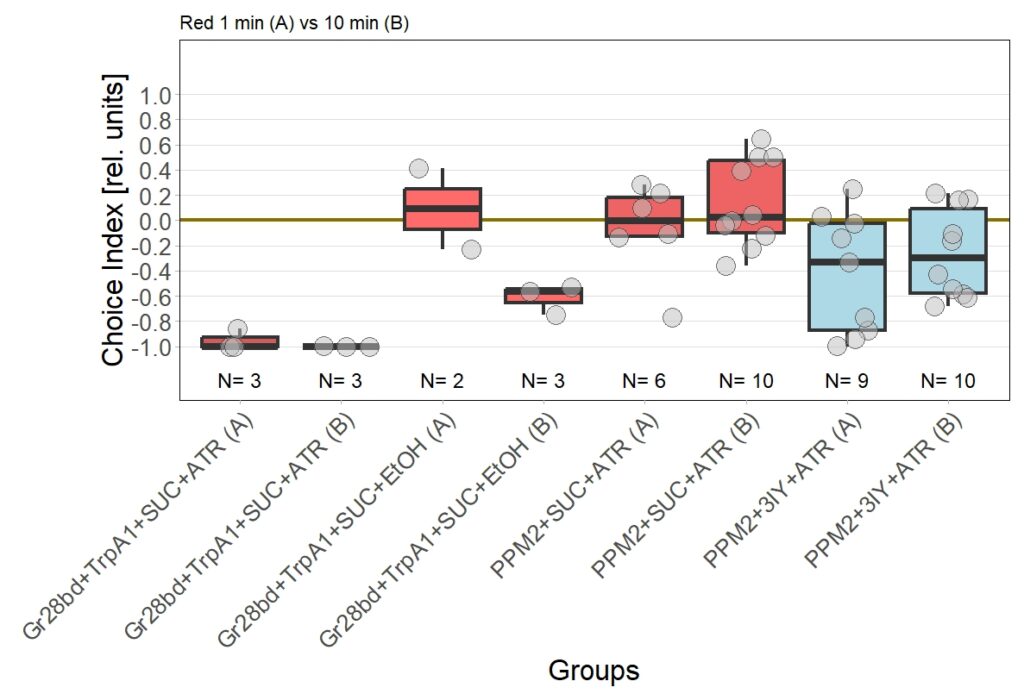
Leading to an updated version of all results:

Category: Optogenetics | No Comments
Almost there
on Monday, October 27th, 2025 12:47 | by Daniel Döringer
In this set of JoyStick experiments, I tested flies expressing the CsChrimson channel in OA-VuMa octopaminergic neurons, which are the Drosophila counterparts to the honeybee OA-VUMmx1 neurons. There are still a few flies left, but for now activation of these neurons does not seem to mediate any strong innate valence. There may be a slight tendency for approach in the alter periods but it might also be by chance, since we can already observe positive values in the pretest.

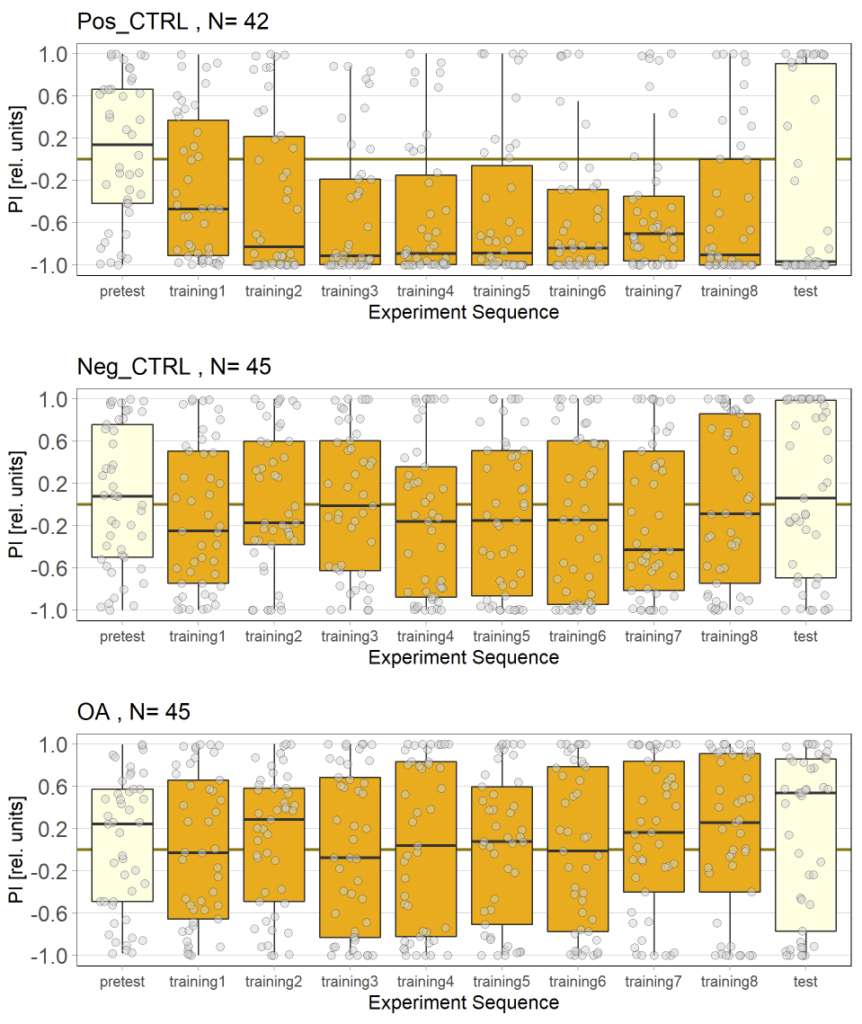
Category: Optogenetics | No Comments
T-Maze results dopamine inhibition
on Monday, July 28th, 2025 11:54 | by Daniel Döringer
Confirmation of 3IY+ATR
After figuring our how to apply 3IY to the flies and confirming that we can simply mix in the ATR with the sucrose to apply it, I stumbled upon another problem: when 3IY and ATR are used together the tissue paper will go from yellow to orange:
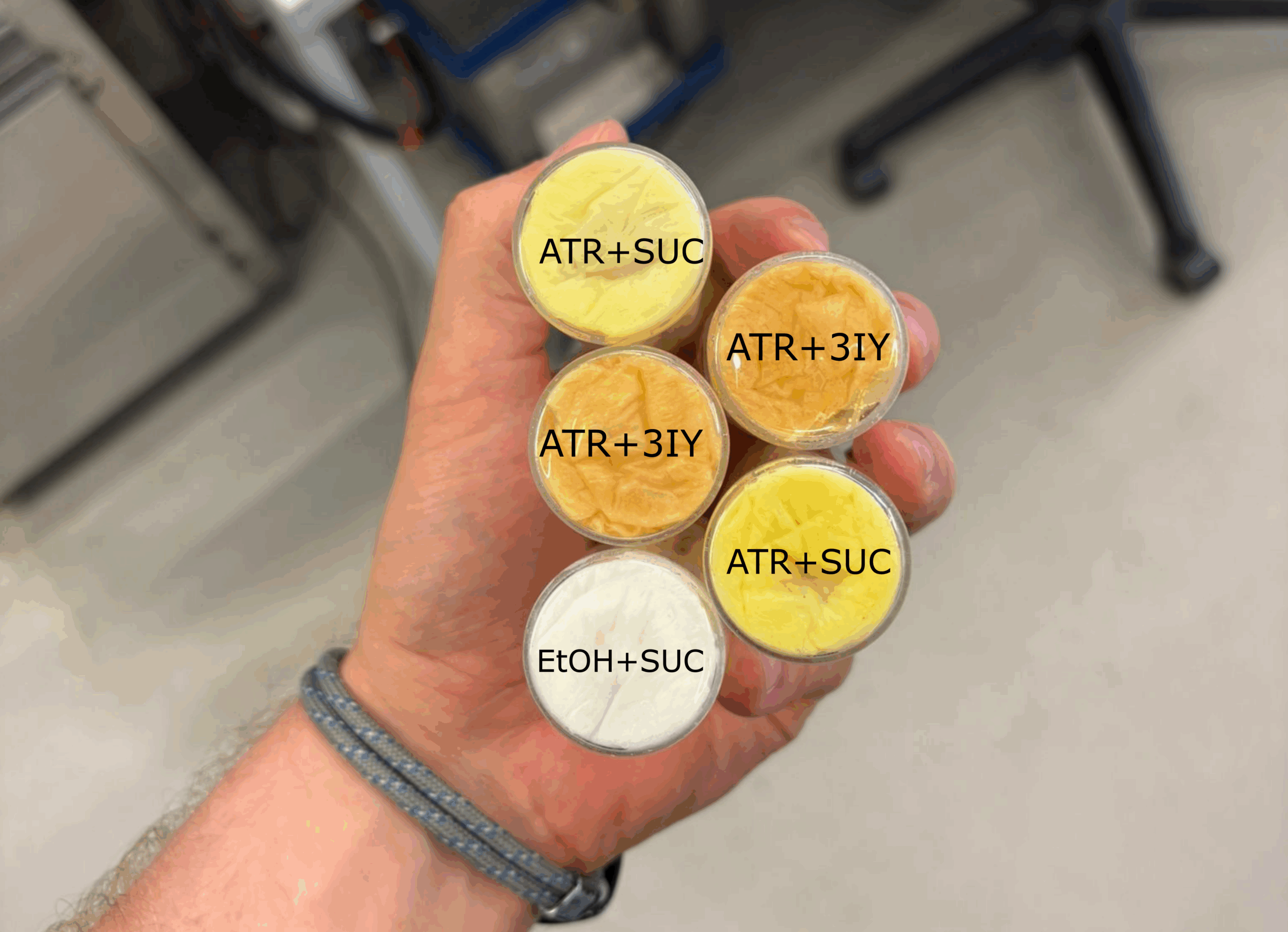
Since we cannot know if this affects the action of 3IY I conducted a final trial in the open field, measuring locomotion of WTB flies after treating them with 3IY and ATR for 48h.
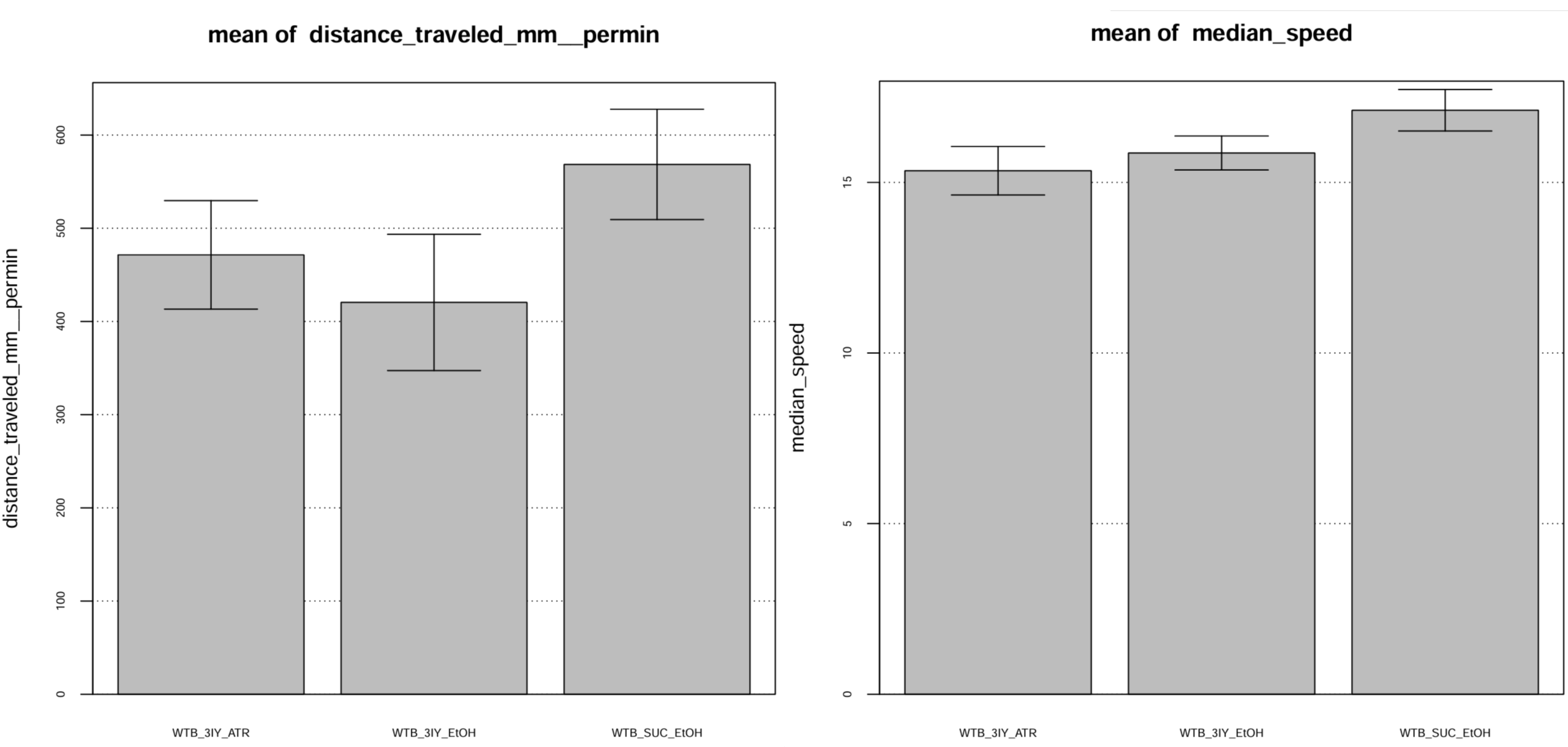
NWTB_3IY_ATR = 16 ; NWTB_3IY_EtOH = 13; NWTB_SUC_EtOH = 8
It seems, that ATR does not affect the action of 3IY and we can proceed with our experiments.
T-Maze results
These are the first results from the set of T-Maze experiments with 3IY treatment. I used red light (1600 Lux) with a decision time of one minute. P-values above plots indicate results of Wilcoxon’s test.
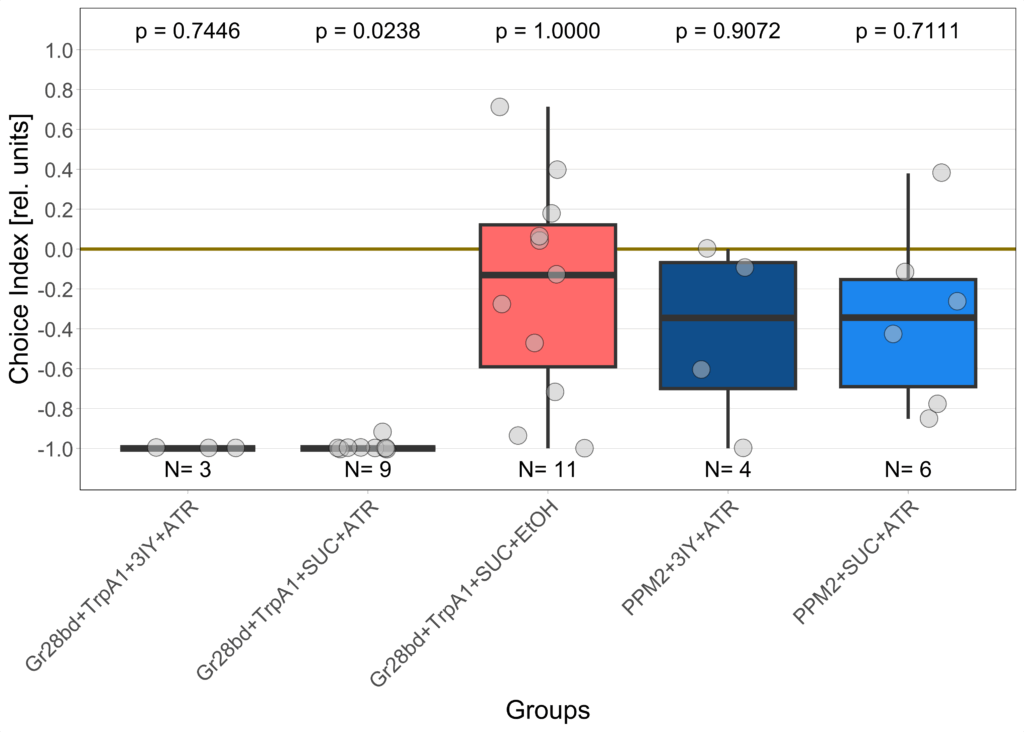
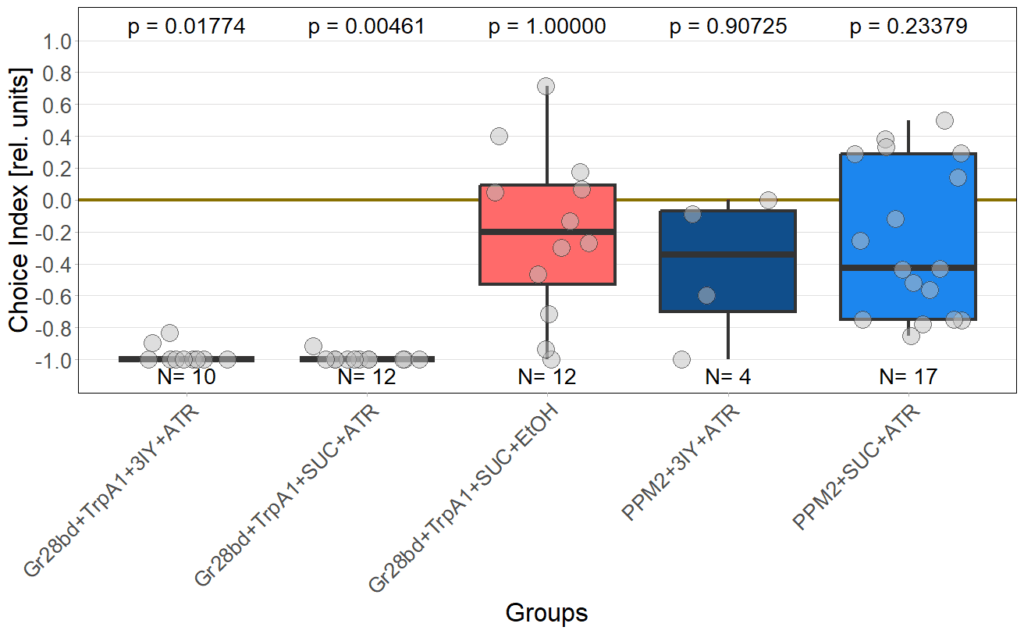
Category: Optogenetics | No Comments
JoyStick results for re-testing PPM2 flies
on Monday, June 2nd, 2025 1:58 | by Daniel Döringer

It’s not yet confirmed, that the 3IY treatment is working
Category: Optogenetics, Uncategorized | No Comments
T-Maze CIs and JoyStick Last Training PIs for yellow and red light.
on Tuesday, January 7th, 2025 1:45 | by Daniel Döringer
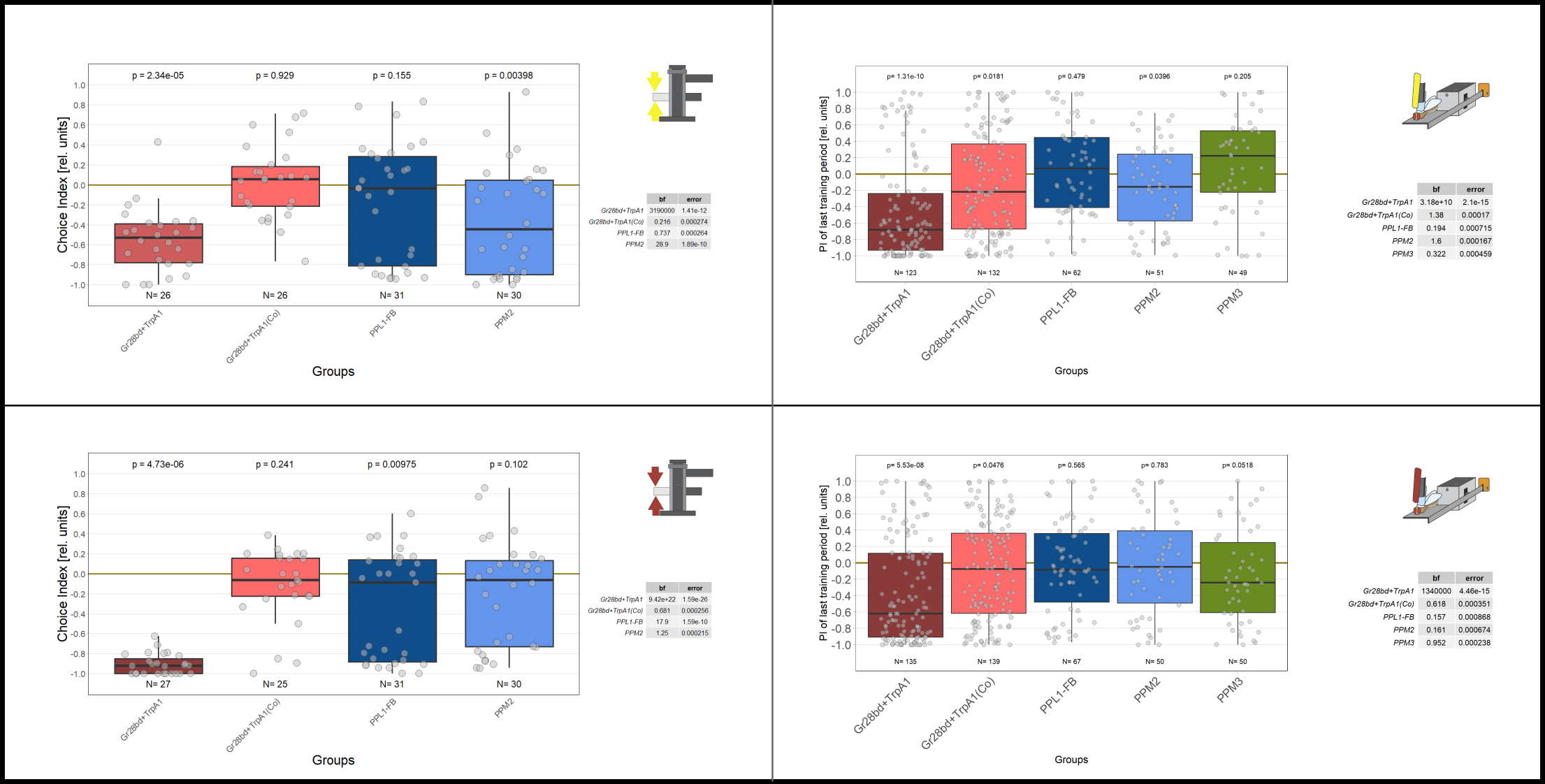
| Strain | DA neurons | Reference |
| SS56699 | PPL1-FB | Hulse et al. eLife 2021 |
| TH-D-DBD; TH-C-AD | PPM2 | Xie et al. Cell Reports 2018 |
| TH-FLP-p10; 64H06 | PPM3 | Xie et al. Cell Reports 2018 |
The left-hand side of the figure displays the choice indices (CIs) for the different groups tested for 1 minute in the T-Maze setting. On the right-hand side, the preference indices (PIs) for the final training period in the JoyStick setting are shown. Since flies of the TH_Flp_p10;64H06 line were not blind, they could not be tested in the T-Maze setting. The upper part of the figure refers to experiments conducted with yellow light, while the bottom part to experiments with red light, as indicated by the graphics.
In previous posts I referred to the different dopaminergic neurons (DA neurons) with the names of the driver lines used for the crossings. The table below the figure connects the fly strains to the targeted neurons and gives the reference. Gr28bd+TrpA1 target heat sensing neurons and acted as a control, since flies expressing the chrisom channel in these heat sensing neurons would avoid light activation. Flies were fed with all-trans retinal (ATR) for 2 days before the experiments, to enable light activation of the targeted neurons. For the negative control ethanol was used.
In the T-Maze experiments, flies were tested for 1 minute without prior exposure to light, whereas the JoyStick results reflect preferences after nine 1-minute training periods. Therefore, the T-Maze experiments should be repeated using longer testing periods. Additionally, PIs from the initial training periods in the JoyStick experiments will be included to allow for better comparison.
Hulse et al. eLife 2021: https://doi.org/10.7554/eLife.66039
Xie et al. Cell Reports 2018: https://doi.org/10.1016/j.celrep.2018.03.068
Category: Optogenetics | No Comments
Update: T-Maze results after QC
on Sunday, September 15th, 2024 1:33 | by Daniel Döringer
For all experiments 30 or more flies were introduced to the T-Maze.
Results for red light
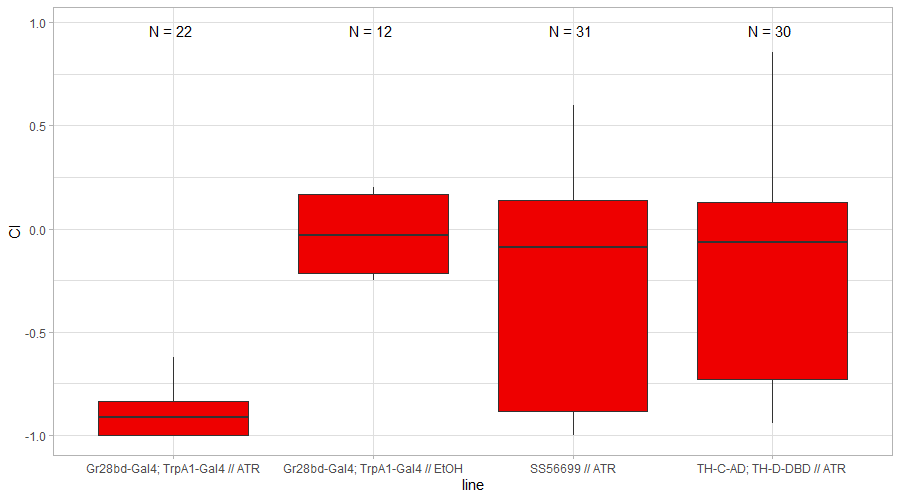
Results for yellow light
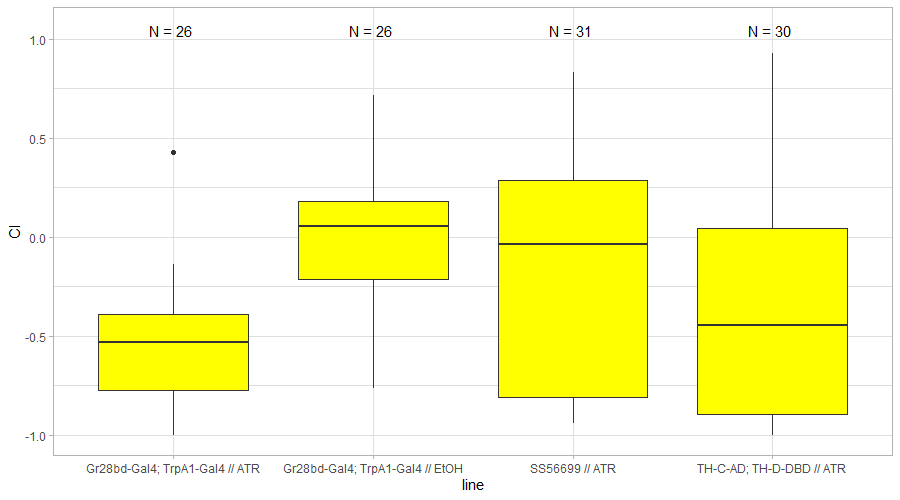
Category: Optogenetics | No Comments
Updated (and visually more appealing) pre-vacation results
on Sunday, September 15th, 2024 1:26 | by Daniel Döringer
Results for red light
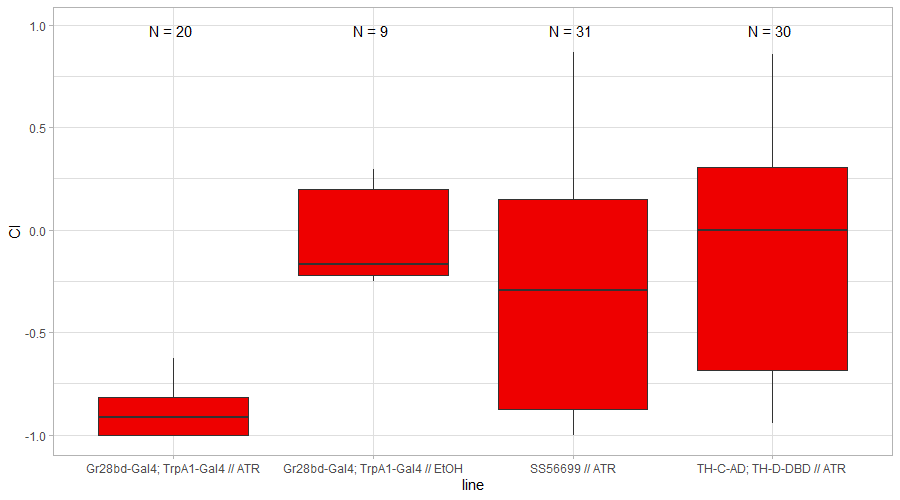
Results for yellow light
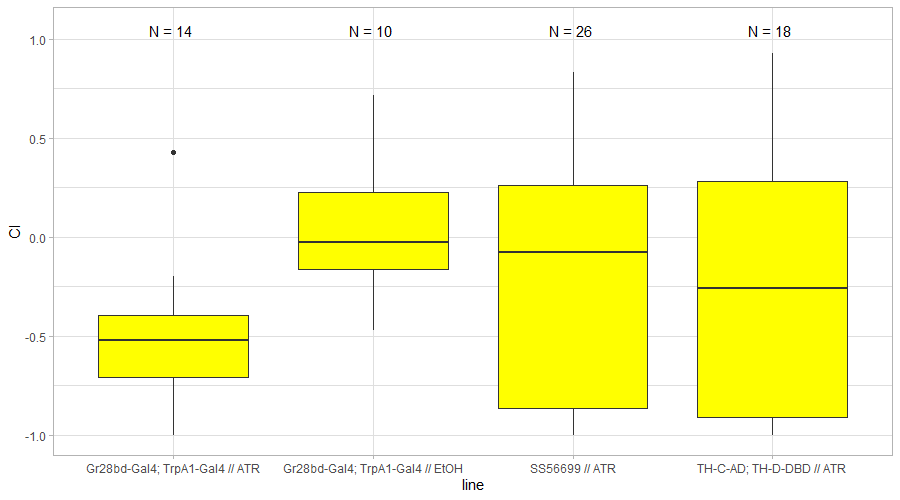
Category: Uncategorized | No Comments
Joystick Results for 2-minute-testing
on Tuesday, May 30th, 2023 1:31 | by Luisa Guyton
The following figures show the results of the joystick test using the same test line as before. In addition, the flies were fed not only ATR but also 3IY (3-iodo-L-tyrosine), an inhibitor of dopamine synthesis. This was done to determine whether the previously observed effect was due to dopamine alone and could therefore be suppressed by the inhibitor, or whether other factors also influenced the flies’ behaviour in the joystick test.
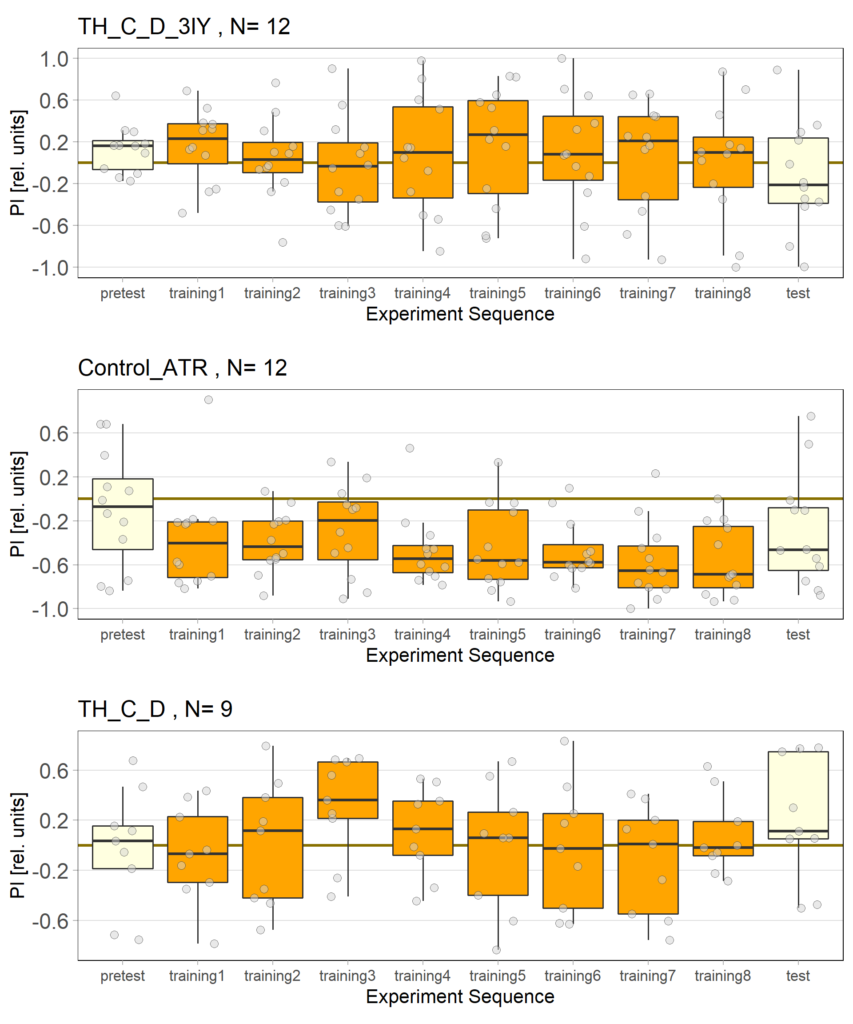
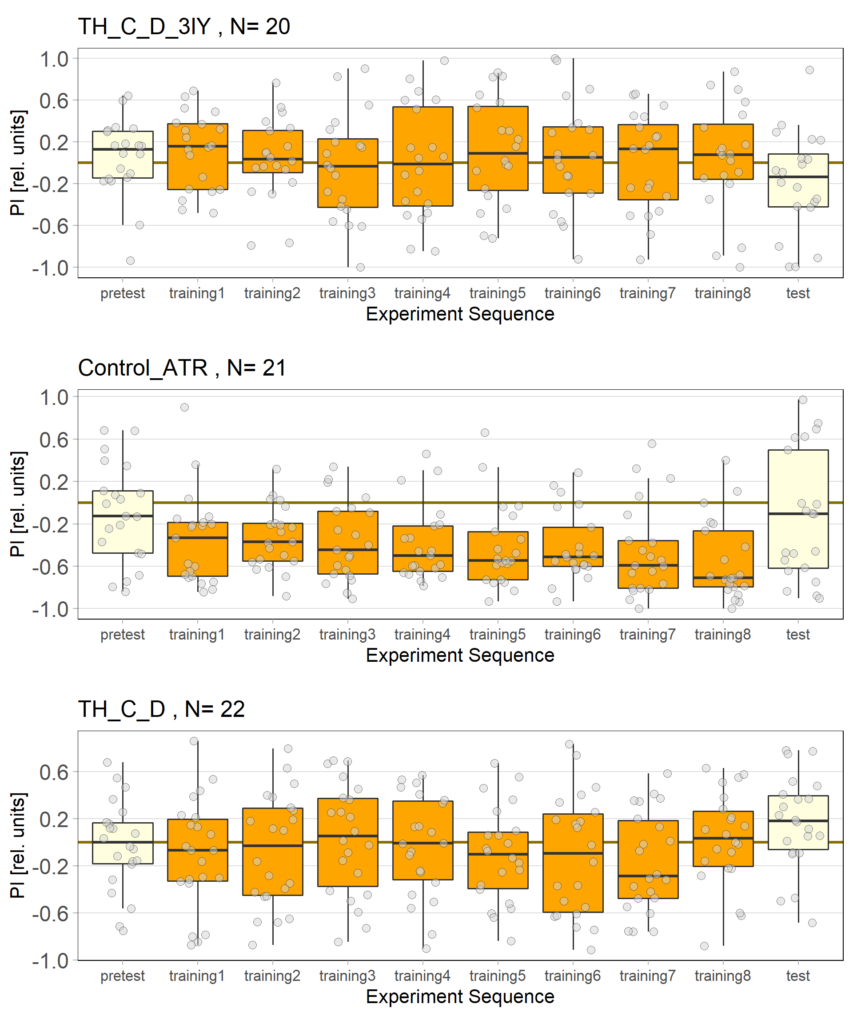
Category: Optogenetics | No Comments
Red light Joystick Results
on Monday, April 3rd, 2023 12:33 | by Luisa Guyton

Category: Optogenetics | No Comments